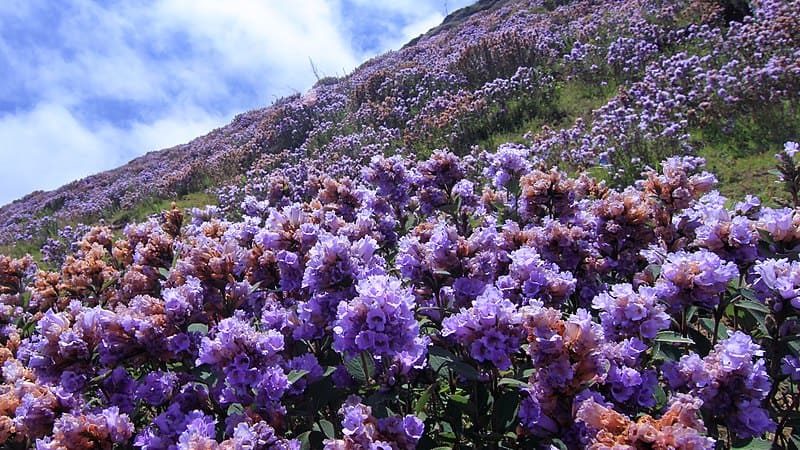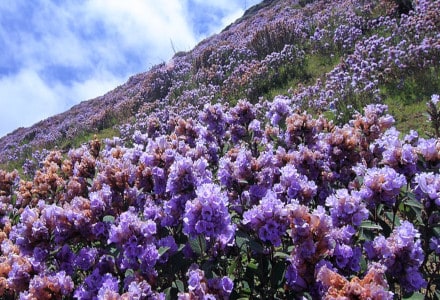
Kurinji Facts
- The truly stunning plant named the Kurinji has an amazing story to tell those who are willing to listen. Yet sadly, the plant also has a quite limited zone of habitation. This was not always the case for this incredibly beautiful plant, however.
- Moreover, this breathtaking species evolved as what science calls generally a plietesial. This somewhat complex term simply means that it developed into a long interval bloomer. In fact, the species only blooms once every 12 years.
- Some related species have bloom rates of every seven years, as well. Although this characteristic is amazing, the genetic trait appears in about 250 species in the genus. But sadly, once the magnificent plant blooms, it has reached the end of its life.
- The IUCN lists the beautiful Kurinji as Endangered, on its Red List. This could change for the worse in the near future. Unfortunately, only a portion of its quite tiny area enjoys protection. That’s true since it forms part of a sanctuary.
- Of all known long interval species, the Kurinji has been the most studied. Because of its fascinating lifecycle, the Strobilanthes kunthiana, as it’s known to researchers, has been used by the local inhabitants as a way to mark their ages.
Related Articles
Kurinji Physical Description
Notably, the Kurinji bears the classification of a shrub. But, the plant remains a relatively small example of one, compared to related species. That’s because most specimens of the shrub only reach a height ranging from 12-24 in (30-60 cm) in the wild.
As is easily apparent, the beauty of the plant comes largely from its stunning blooms. These magnificent yet delicate flowers usually appear in comparatively small clusters, though. In color, these blooms present a very specific range of colors.
This range of coloration most commonly consists of light to dark shades of the color purple. These delicate flowers also average about 1 in (2.5 cm) in length. In addition, the stalks of the magnificent Kurinji evolved a distinctly different trait of their own.
This statements stands on its own merit, since these display a reddish color, combined with a surprisingly smooth texture. In contrast, however, its leaves have a leathery texture and dark green color. Generally, these measure about 1.18 – 3.36 in (3 x 6 cm).
- Kingdom: Plantae
- Phylum: Angiosperms
- Class: Eudicots
- Order: Lamiales
- Family: Acanthaceae
- Genus: Strobilanthes
- Species: S. kunthiana
Kurinji Distribution, Habitat, and Ecology
Evolution provided the Kurinji with a restricted range of habitation. That holds true due to the fact that it apparently evolved solely as native to the country of India, in Asia. No evidence exists to support the possibility of it ever appearing anywhere else.
Even within this territory, the range of this Angiosperm has now become severely limited. As a result, the great majority of known specimens presently appear in the Western Ghats. A small number of plants nevertheless also exist in the Eastern Ghats, as well.
And once again, Nature gave the visually stunning plant known as the Kurinji yet another highly specific requirement for its flourishing. That remains true since it most commonly grows at high altitudes, ranging from 4,265 -7,874 ft (1,300 – 2,400 m).
This stunning work of evolution also has one more surprise for us. It nearly always appears on the sides of gently sloping hills within that range. Unfortunately, though, mankind has now taken away the great majority of its potential habitat in its range.
That’s true given the fact that the majority of the habitat remaining to it is now covered with numerous residences and plantations. In point of fact, only the Kurinjimala Sanctuary, which covers a scant 12.3 sq mi (32 sq km) offers the species secure protection.
Species Sharing Its Range
Check out our other articles on 5 Spellbinding Scorpions, Kali Gandaki Gorge, Australian Ghost Shark, Blue Death Feigning Beetle, Indian Giant Squirrel, Plumed Basilisk

